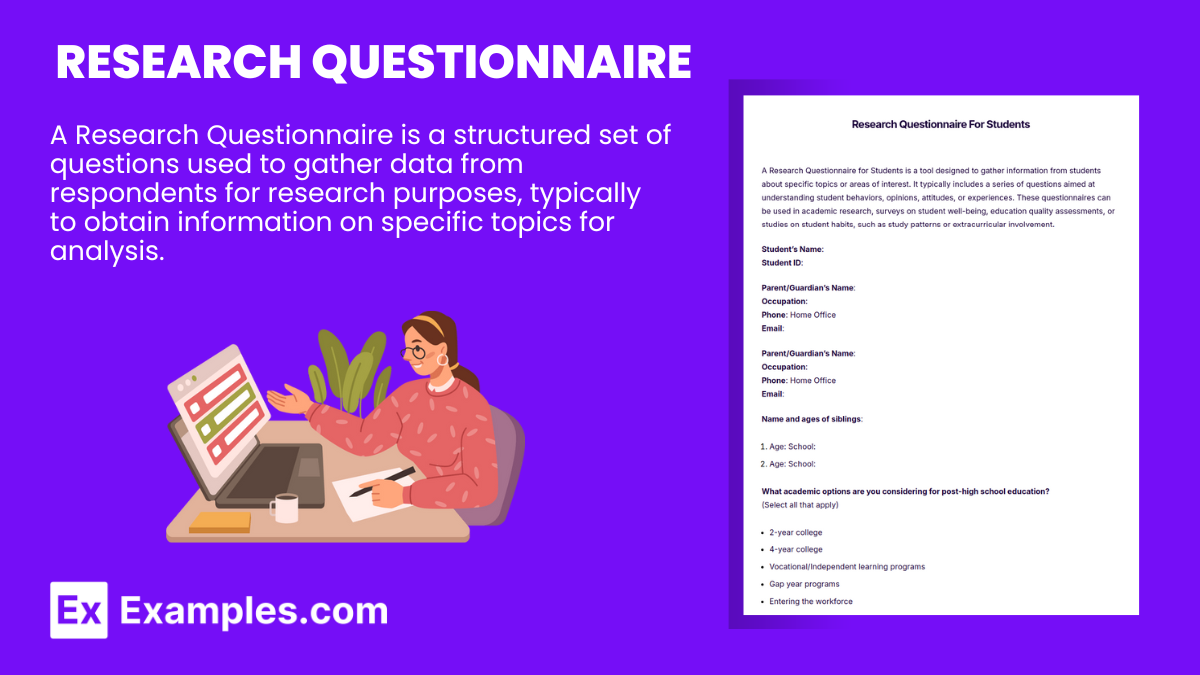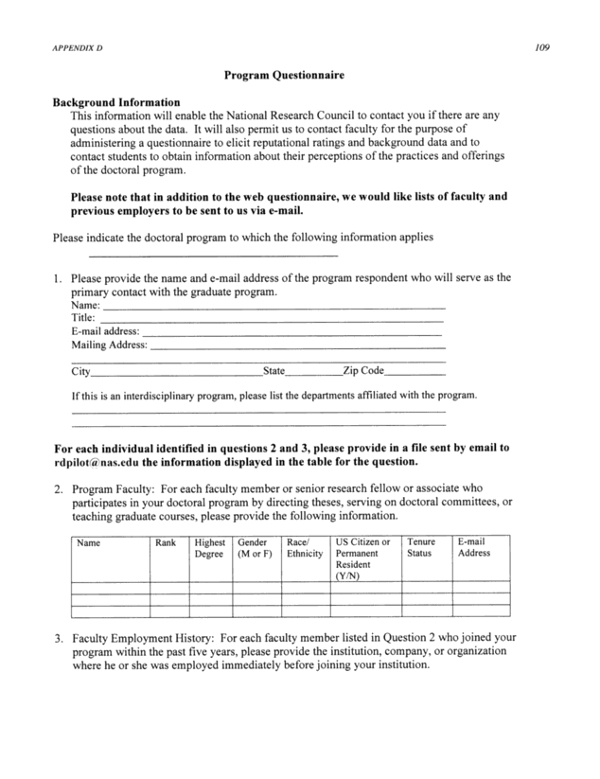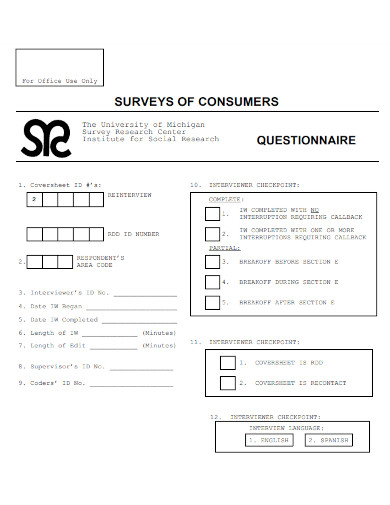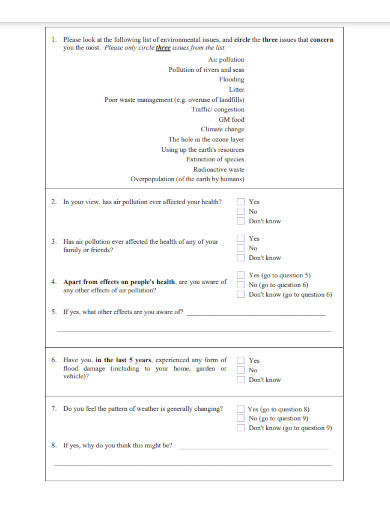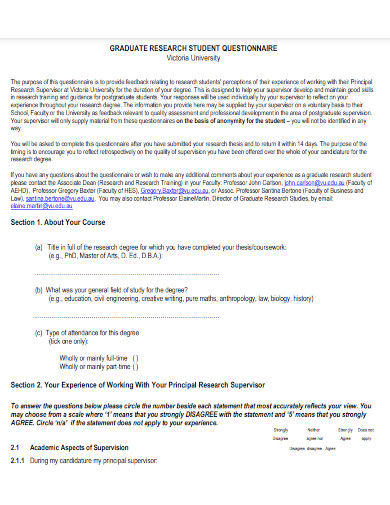3+ Research Questionnaire Examples to Download
When a researcher creates a research paper using the scientific method they will need to use a gathering method that is adjacent to the research topic. This means that the researcher will use a quantitative research method for a quantitive topic and a qualitative method for a qualitative one. The research questionnaire is one of the quantitative data-gathering methods a researcher can use in their research paper.
What is Research Questionnaire?
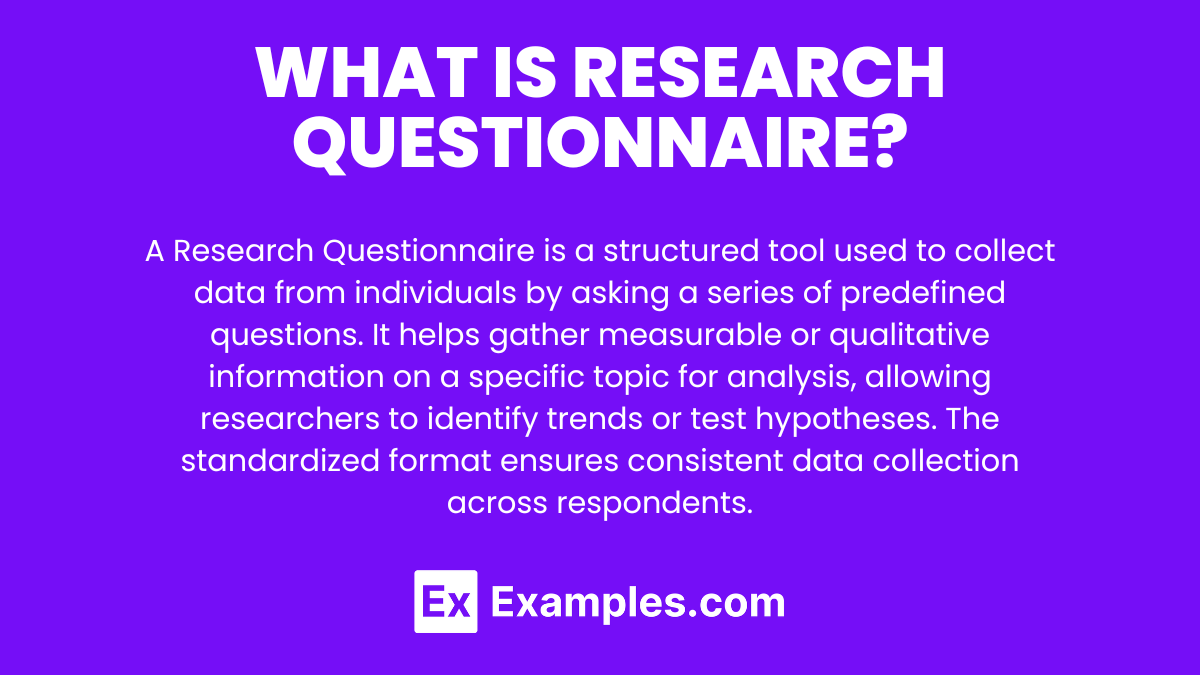
Research Questionnaire Examples Bundle
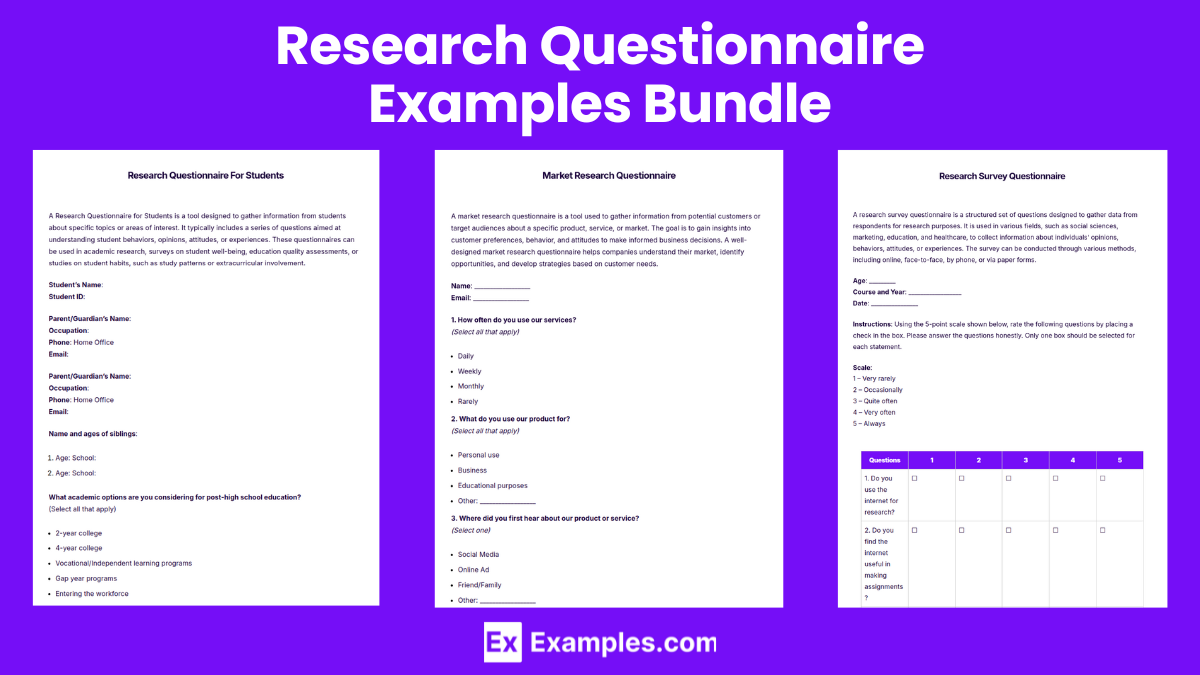
Download Research Questionnaire Bundle
Research Questionnaire Format
Opening Remarks
Greeting: Start with a polite and professional greeting.
Example: “Hello and thank you for participating in our research study.”
Introduction
Purpose: Briefly explain the purpose of the questionnaire.
Example: “This questionnaire is designed to gather insights on consumer behavior in online shopping.”
Instructions
Guidance: Provide clear instructions on how to complete the questionnaire.
Example: “Please answer all questions honestly. This survey will take approximately 10 minutes to complete.”
Questionnaire Sections
Section 1: Demographics
Purpose: Collect basic demographic information about the respondent.
Example: “Please fill in your age, gender, and education level.”Section 2: Behavioral Questions
Purpose: Ask questions related to the specific behaviors or opinions being researched.
Example: “How often do you shop online in a month?”Section 3: Opinions and Preferences
Purpose: Explore respondents’ opinions or preferences related to the study topic.
Example: “What is the most important factor when choosing an online shopping platform?”Section 4: Likert Scale Questions
Purpose: Use a scale to gauge the intensity of feelings or agreement on certain statements.
Example: “Please rate your agreement with the following statement: ‘I prefer online shopping over in-store shopping.’ (1 = Strongly Disagree, 5 = Strongly Agree)”
Closing Remarks
Summarize: Briefly recap the importance of the data being collected.
Example: “Your responses are crucial to understanding consumer preferences in the online shopping market.”Final Thanks: Offer a word of appreciation for the respondent’s participation.
Example: “Thank you for taking the time to complete this questionnaire.”
Farewell
Goodbye: End with a polite and professional farewell.
Example: “We greatly appreciate your participation. Have a great day!”
Research Questionnaire Example
Good day, participants,
I stand before you to express our sincere gratitude for taking the time to participate in this research study.
First and foremost, I would like to introduce this research questionnaire, which aims to gather valuable data on [research topic, e.g., “consumer behavior in online shopping”]. Your input will help shape our understanding and contribute significantly to this area of study.
Our sincere thanks to the research team for their efforts in designing this questionnaire. Special appreciation also goes to the respondents who have agreed to take part in this study. Your honest and thoughtful responses are invaluable.
We are also grateful for the support of our collaborators and data analysts who will be working behind the scenes to ensure the data is properly processed and interpreted. Without your collective support, this research would not be possible.
In conclusion, we appreciate the time and effort each of you has invested in completing this questionnaire. Your participation helps move this research forward, and for that, we are truly thankful.
Thank you once again for your contributions. We wish you all the best and look forward to the outcomes of this important research.
Short Research Questionnaire Example
Good day, participants,
I stand here to sincerely thank you for taking the time to participate in this research study.
First, this research questionnaire has been designed to gather key insights on [research topic]. Your participation is essential to our study.
A big thank you to all who are involved in this research process, especially the participants for their valuable contributions.
Lastly, we extend our gratitude to the research team and support staff for their efforts in ensuring this questionnaire runs smoothly.
Thank you all once again for your time and support. We appreciate your input and look forward to the results of this research.
Research Questionnaire For Students
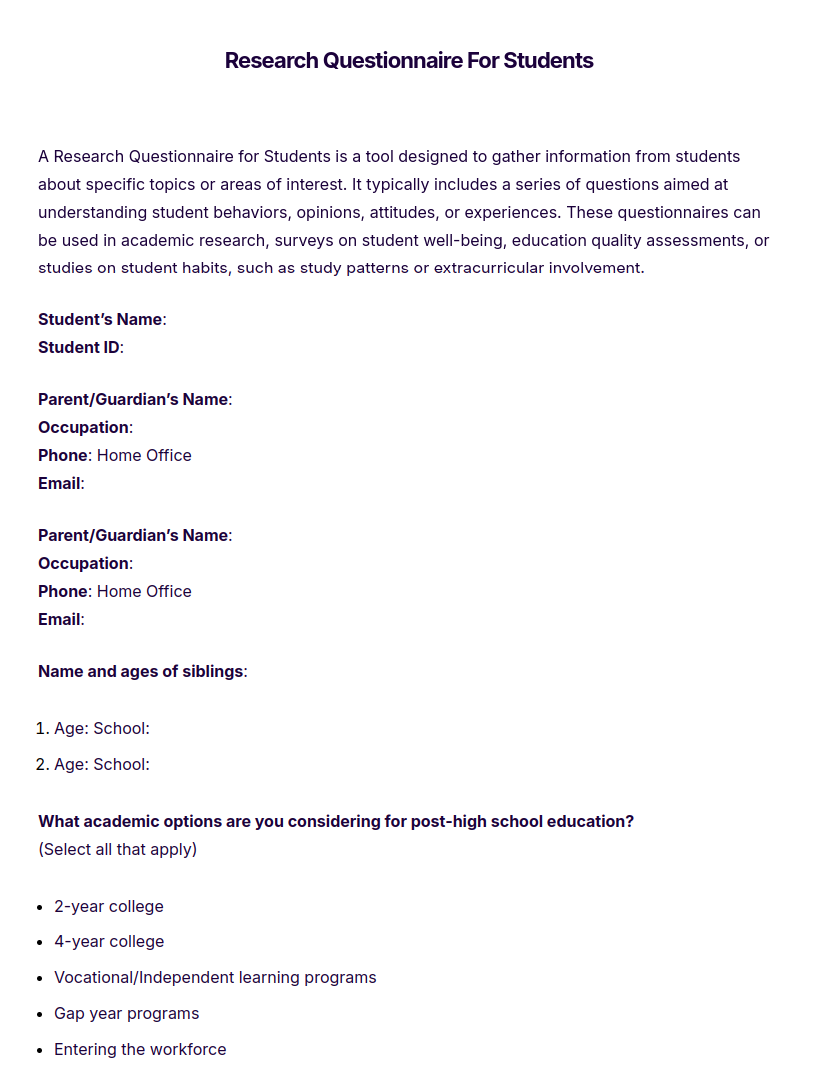
Market Research Questionnaire
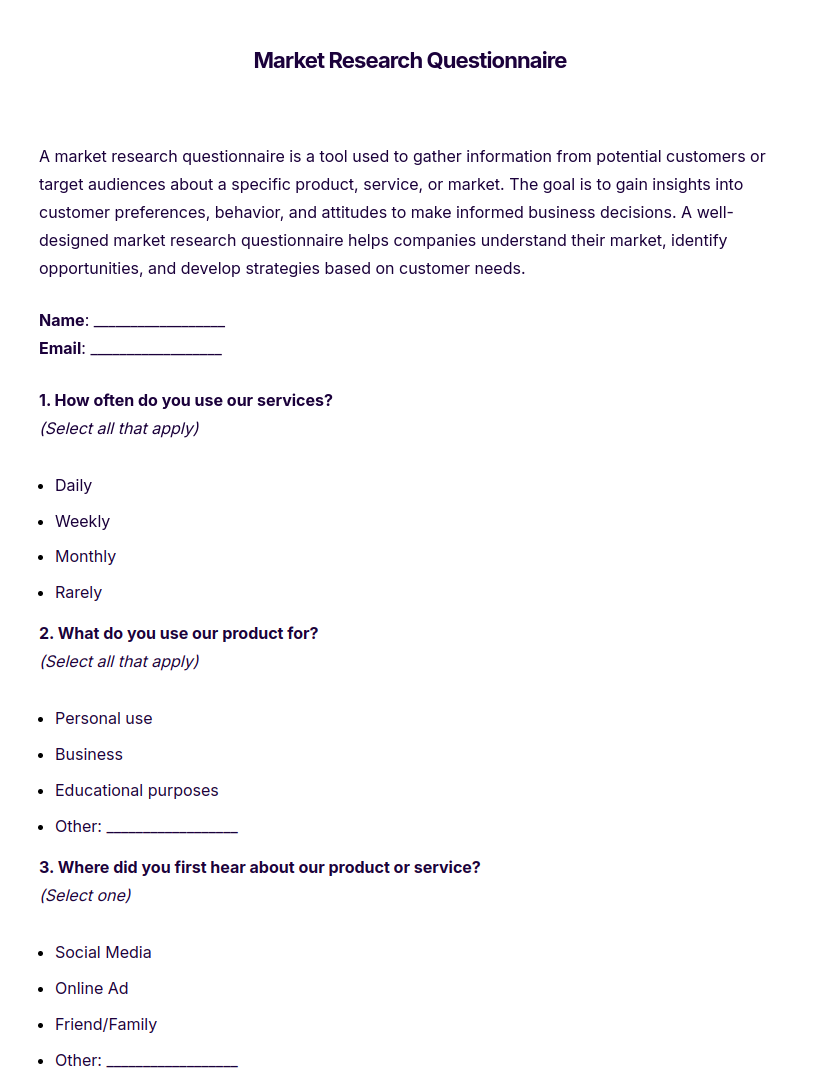
Research Survey Questionnaire
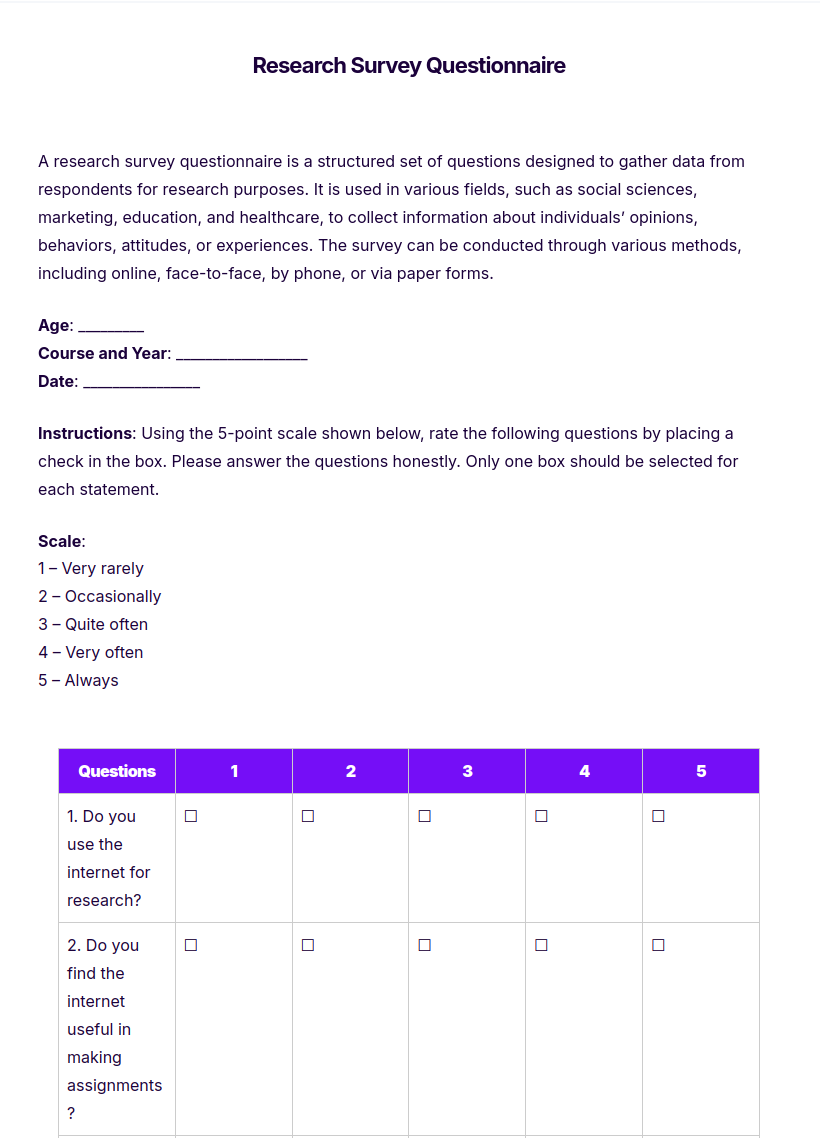
More Research Questionnaire Examples and Samples
1. Research Program Questionnaire Example
2. Research Questionnaire Survey of Consumers
3. Climate Change Research Survey Questionnaires
4. Graduate Research Student Questionnaire
How to Write Research Questionnaire?
Writing a research questionnaire involves careful planning and structuring to ensure you collect relevant and reliable data. Here is a step-by-step guide on how to write a research questionnaire:
Define the Research Objective
Before writing the questionnaire, clearly define the objective of your research. What specific information do you want to gather? Understanding the purpose will help guide the types of questions you ask.
Identify the Target Audience
Know who your respondents are (e.g., age, education, profession, geographic location). This will influence how you word your questions and what type of questions are most appropriate.
Choose the Type of Questions
Decide what type of questions will best serve your research:
Closed-ended questions: These offer predefined answer options and are useful for quantitative data. Types include:Yes/No questions
Multiple-choice questions
Likert scale questions (e.g., strongly agree to strongly disagree)
Open-ended questions: These allow respondents to answer in their own words and are useful for qualitative data.Develop Clear and Concise Questions
Keep questions short and simple: Avoid complex wording and jargon that may confuse respondents.
Avoid leading questions: Ensure that questions are neutral and do not guide respondents toward a specific answer.
Be specific: Vague questions can result in unclear responses. Make sure the question is focused on what you want to know.Use a Logical Flow
Structure your questionnaire in a logical order:
Start with easy, non-sensitive questions: This helps build rapport and makes respondents comfortable.
Group similar questions: This ensures a natural flow and helps respondents stay focused.
Move from general to specific questions: Begin with broader topics and narrow down to more detailed questions.Pre-Test and Pilot the Questionnaire
Before distributing your questionnaire, conduct a pre-test or pilot study with a small group of people from your target audience. This helps you identify any confusing or ambiguous questions, and allows you to make adjustments before the full launch.
Include Demographic Questions
Demographic questions (e.g., age, gender, education) are important if you need to categorize responses by specific groups. Place these either at the beginning or end of the questionnaire, depending on the sensitivity of the information.
Add Instructions Where Necessary
If a question requires special consideration, provide clear instructions. For example, for Likert scale questions, explain what each rating means.
Ensure Ethical Considerations
Inform respondents about the purpose of the questionnaire, how their data will be used, and ensure confidentiality. Obtain consent where necessary.
Keep It Short and Focused
A lengthy questionnaire can lead to respondent fatigue and incomplete responses. Focus on only the most important questions related to your research objectives.
Types of Research Questionnaire
There are several types of research questionnaires that researchers use based on the study design, data type, and objectives. These questionnaires can vary in format, structure, and purpose. Below are the main types:
1. Structured Questionnaire
- Definition: A structured questionnaire consists of predefined, closed-ended questions where the answer options are limited and set by the researcher.
- Purpose: Used to collect quantitative data in a systematic way, often in large-scale surveys.
- Characteristics:
- Fixed response options (e.g., multiple choice, Yes/No, Likert scale).
- Standardized for all respondents.
- Example: “How often do you exercise per week? (a) Never, (b) 1–2 times, (c) 3–4 times, (d) 5+ times.”
2. Unstructured Questionnaire
- Definition: An unstructured questionnaire consists of open-ended questions where respondents can freely express their thoughts and feelings.
- Purpose: Used to collect qualitative data, allowing for more in-depth exploration of a topic.
- Characteristics:
- No predefined answer options.
- Respondents can provide more detailed responses.
- Example: “Can you describe your experience with remote learning during the pandemic?”
3. Semi-Structured Questionnaire
- Definition: A semi-structured questionnaire combines both open-ended and closed-ended questions, providing a balance between structured data collection and flexibility.
- Purpose: Used in mixed-method research to gather both qualitative and quantitative data.
- Characteristics:
- Some questions are predefined with fixed responses, while others allow free responses.
- Example: “How satisfied are you with our customer service? (Likert scale) Please explain why you feel this way (open-ended).”
4. Self-Administered Questionnaire
- Definition: A questionnaire that respondents complete on their own without the direct involvement of a researcher.
- Purpose: Used in surveys, feedback forms, and opinion polls where respondents can fill it out at their convenience.
- Characteristics:
- Typically distributed online, via email, or in person.
- Respondents complete it independently.
- Example: Online survey about shopping habits sent to customers via email.
5. Interviewer-Administered Questionnaire
- Definition: A questionnaire where the researcher or interviewer asks the questions directly and records the respondent’s answers.
- Purpose: Used in situations where clarification is needed or where the questions might be complex.
- Characteristics:
- The interviewer reads the questions and records responses.
- Allows for clarification of misunderstandings during the interview.
- Example: Face-to-face interview for collecting demographic and employment data.
6. Closed-Ended Questionnaire
- Definition: A questionnaire where all questions have fixed responses (e.g., multiple choice, rating scales, Yes/No).
- Purpose: To gather quantitative data that is easy to analyze statistically.
- Characteristics:
- Respondents choose from a list of predefined answers.
- Suitable for large-scale surveys with numerical data analysis.
- Example: “On a scale of 1 to 5, how likely are you to recommend this product?”
7. Open-Ended Questionnaire
- Definition: A questionnaire that allows respondents to answer questions in their own words without being constrained by predefined options.
- Purpose: To gather detailed qualitative data that explores deeper insights.
- Characteristics:
- No restrictions on how respondents can answer.
- Results in descriptive or narrative responses.
- Example: “What do you think could be improved in our current service?”
8. Online Questionnaire
- Definition: A questionnaire that is distributed and completed electronically, typically via email, social media, or online platforms (e.g., Google Forms).
- Purpose: To collect data efficiently from a broad, diverse audience.
- Characteristics:
- Fast distribution and easy to access.
- Allows for automated data collection and analysis.
- Example: A customer satisfaction survey distributed via a company’s website.
Tips for Research Questionnaire
Here are some tips for creating an effective research questionnaire:
- Clarify your research objectives to ensure that every question contributes to answering the main research questions.
- Tailor the language, complexity, and format of the questions based on your target audience’s demographics, such as age, education level, or cultural background.
- Use simple, clear, and concise language to avoid confusion and ensure respondents understand the questions.
- Keep questions focused by asking only one thing at a time and avoiding double-barreled questions that address more than one issue.
- Use a logical flow, starting with easy questions and gradually moving to more complex or sensitive ones to maintain engagement.
- Include a mix of question types, such as closed-ended and open-ended questions, depending on the type of data you need.
- Avoid leading or biased questions, which may influence respondents’ answers. Ensure questions are neutral to gather unbiased responses.
- Pilot test the questionnaire with a small group to identify confusing or unclear questions, and make necessary revisions before distributing it widely.
FAQS
How do I design a good research questionnaire?
To design a good research questionnaire, clarify your research objectives, know your target audience, use simple and clear language, ask one question at a time, avoid leading or biased questions, and ensure the questions are logically ordered. You should also pilot test your questionnaire before using it in full research.
How long should a research questionnaire be?
The length of the questionnaire depends on your research objectives and the complexity of the information needed. However, it should be as concise as possible to avoid respondent fatigue. Aim for a balance between gathering sufficient data and keeping respondents engaged.
How many questions should be in a research questionnaire?
The number of questions depends on the scope of the research but typically ranges from 10 to 50 questions. It’s important to balance the depth of data with respondent fatigue.
How should I interpret the results of a research questionnaire?
Results should be analyzed based on the research objectives. Quantitative data can be statistically analyzed, while qualitative data should be interpreted by identifying key themes or patterns.
What are the key components of a questionnaire?
Introduction: Explains the purpose of the research.
Instructions: Provides guidance on how to answer the questions.
Questions: The core of the questionnaire.
Conclusion: Thanks the respondent and may provide contact information for further queries.


